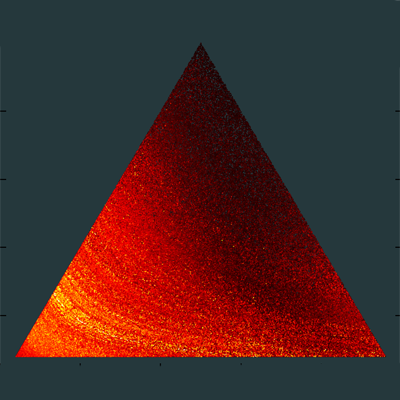Ability of a bank of waveform templates to detect binary black holes with non-zero spin. Each point represents a simulated signal; horizontal and vertical axes are the masses of each black hole in the simulation. The more yellow a point, the more signal-to-noise ratio is lost due to discreteness in the bank. This was used to justify using another template bank which provided better coverage, and which was used to detect binary black holes in the first two observing runs of Advanced LIGO. From C. Capano, I. Harry, S. Privitera, and A. Buonanno, Phys. Rev. D 93, 124007 (2016). Image was featured in the Phys. Rev. D Kaleidoscopes, June 2016.
Gravitational-wave searches
Key to LIGO’s success has been the ability of searches to find signals in a background of detector noise. This is complicated by the presence of non-Gaussian transient noise in the data, which increase the rate of false alarms. Mitigating the effects of this noise and measuring the significance of candidate events are critical components of search pipelines.
The first several years of my research career was focused on improving the sensitivity of the search for gravitational waves from compact-binary mergers, in anticipation of the start of Advanced LIGO (which began in 2015). I worked on expanding the search parameter space to include black holes with spins and large masses. Maximizing the probability of making a detection meant balancing the desire to cast a wide net with mitigating trials factors arising from the “look elsewhere effect“. This was just one of many careful considerations the LIGO Scientific Collaboration (LSC) had to make leading up to the first detection. The smashing success of Advanced LIGO and Virgo is the result of many years of hard work carried out by thousands of scientists working on a plethora of challenging problems like these.
Multimessenger searches
Now that gravitational-wave detections have become routine, myself and several colleagues are working on applying the lessons we learned from searching for gravitational waves to searching for sub-threshold, multimessenger signals. As demonstrated by GW170817 — the first detection of a binary neutron star merger, and the first event to be observed both by gravitational-wave detectors and electromagnetic telescopes — multimessenger observations are gold mines of knowledge. For this reason, telescopes are constantly on alert, ready to point to potential new gravitational wave sources as they are announced in hopes of making another joint detection. However, GW170817 was fortuitously close to us, making it relatively easy to detect. We expect ~2 or fewer events to occur per year with similar optimal orientation and proximity.
Many more events may be detected if we can dig down into the noise, looking for “sub-threshold” signals. Such signals are not significant in a gravitational-wave or electromagnetic search on its own. However, by combing results between searches, weaker joint signals can be identified. As a proof-of-principle, we performed such a sub-threshold search between Fermi-GBM and the first observation run of Advanced LIGO to look for gamma-ray bursts (GRBs) coincident with a binary neutron star merger. We identified one candidate, determining that it had a ~25% chance of being astrophysical. We are currently working on improving this search and applying it to future observing runs. We also hope to expand our search to include LSST and other wide-field telescopes.
